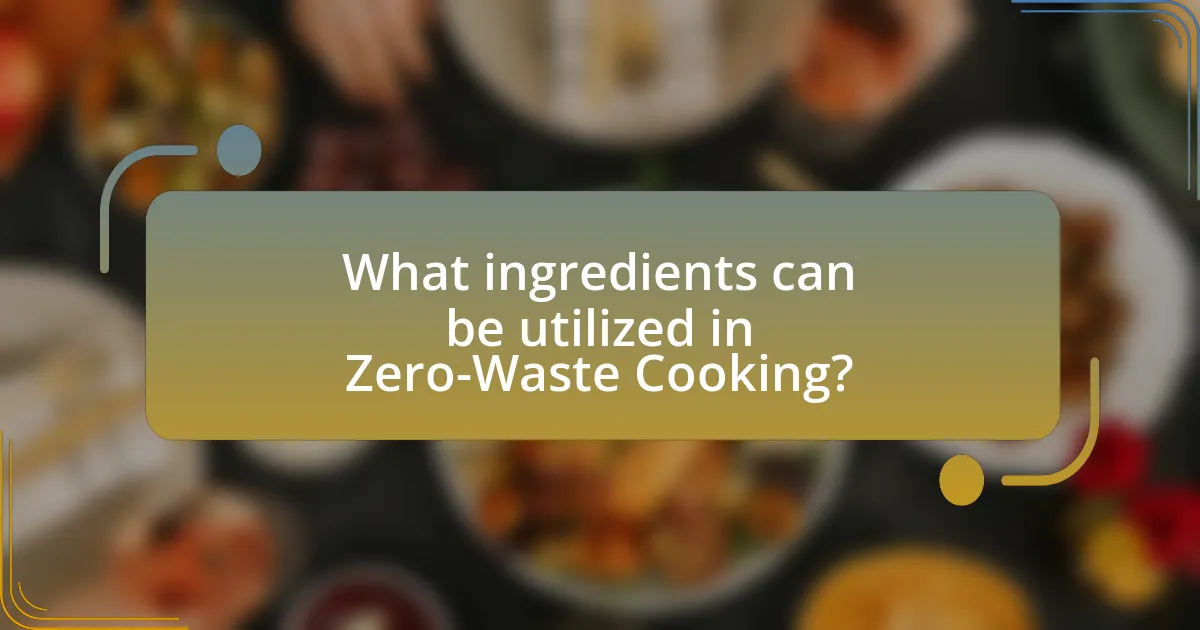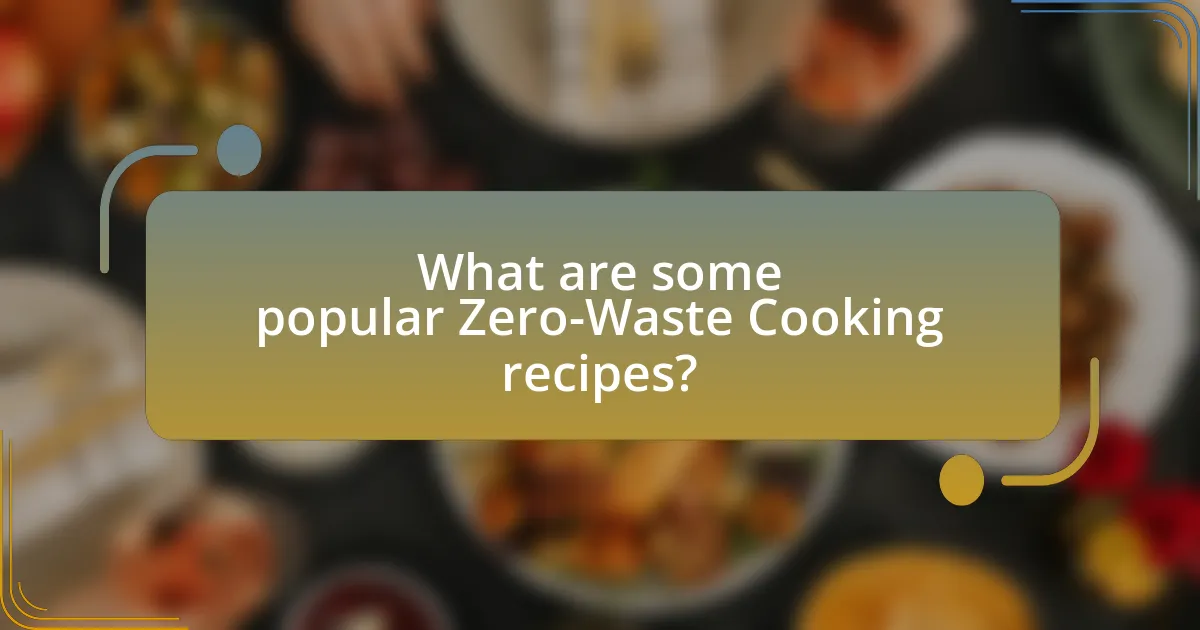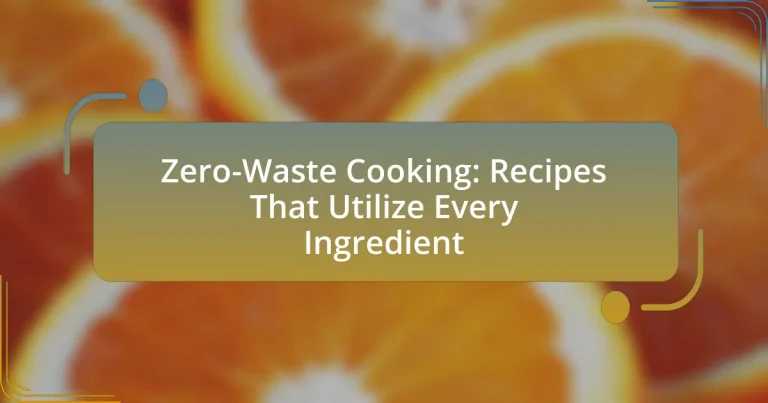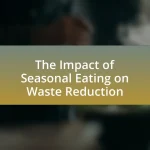Zero-Waste Cooking is a culinary approach focused on minimizing food waste by utilizing every part of an ingredient, including scraps, peels, and leftovers. This method not only reduces waste but also promotes sustainability and resourcefulness in the kitchen, aligning with environmental goals. Key principles include meal planning, composting, and creatively repurposing ingredients, which collectively contribute to a more sustainable food system. The article explores various techniques, recipes, and the environmental benefits of adopting Zero-Waste Cooking practices, emphasizing its importance in reducing food waste and fostering healthier eating habits.

What is Zero-Waste Cooking?
Zero-Waste Cooking is a culinary approach that aims to minimize food waste by utilizing every part of an ingredient. This method encourages the use of scraps, peels, and leftovers in creative ways, transforming them into new dishes or components. For example, vegetable scraps can be used to make broth, while stale bread can be repurposed into croutons or breadcrumbs. The practice not only reduces waste but also promotes sustainability and resourcefulness in the kitchen, aligning with environmental goals to decrease landfill contributions and conserve resources.
How does Zero-Waste Cooking contribute to sustainability?
Zero-Waste Cooking contributes to sustainability by minimizing food waste and promoting resource efficiency. This cooking approach encourages the use of all parts of ingredients, reducing the amount of food discarded and thereby lowering the environmental impact associated with waste disposal. According to the Food and Agriculture Organization, approximately one-third of all food produced globally is wasted, which contributes to greenhouse gas emissions and resource depletion. By adopting Zero-Waste Cooking practices, individuals can significantly decrease their carbon footprint and conserve resources such as water and energy, ultimately supporting a more sustainable food system.
What are the key principles of Zero-Waste Cooking?
The key principles of Zero-Waste Cooking include utilizing all parts of ingredients, planning meals to minimize waste, and composting organic scraps. Utilizing all parts of ingredients means using stems, leaves, and peels that are often discarded; for example, carrot tops can be used in pesto. Planning meals helps in buying only what is necessary, reducing excess food that may go to waste. Composting organic scraps transforms waste into nutrient-rich soil, promoting sustainability. These principles collectively aim to reduce food waste and promote environmental responsibility in cooking practices.
How does Zero-Waste Cooking impact food waste reduction?
Zero-Waste Cooking significantly reduces food waste by promoting the use of all edible parts of ingredients, thereby minimizing discards. This cooking approach encourages practices such as utilizing vegetable scraps for broths, repurposing stale bread into croutons, and incorporating peels and stems into dishes. According to a study by the Food and Agriculture Organization, approximately one-third of food produced globally is wasted, highlighting the importance of strategies like Zero-Waste Cooking in addressing this issue. By adopting these methods, households can decrease their food waste footprint, contributing to a more sustainable food system.
Why is Zero-Waste Cooking important in today’s society?
Zero-Waste Cooking is important in today’s society because it significantly reduces food waste, which is a major contributor to environmental degradation. According to the Food and Agriculture Organization, approximately one-third of all food produced globally is wasted, leading to unnecessary greenhouse gas emissions and resource depletion. By adopting Zero-Waste Cooking practices, individuals can minimize their ecological footprint, promote sustainability, and encourage a more responsible approach to food consumption. This method not only conserves resources but also fosters creativity in the kitchen by encouraging the use of all parts of ingredients, thereby enhancing culinary skills and reducing overall food costs.
What are the environmental benefits of adopting Zero-Waste Cooking?
Adopting Zero-Waste Cooking significantly reduces food waste, which is a major contributor to greenhouse gas emissions. By utilizing every part of ingredients, this cooking method minimizes the amount of organic waste sent to landfills, where it decomposes and releases methane, a potent greenhouse gas. According to the Food and Agriculture Organization, approximately one-third of all food produced globally is wasted, contributing to about 8-10% of total greenhouse gas emissions. Furthermore, Zero-Waste Cooking encourages sustainable sourcing and consumption practices, promoting local and seasonal ingredients that have a lower carbon footprint compared to imported foods. This holistic approach not only conserves resources but also fosters a more sustainable food system.
How does Zero-Waste Cooking promote healthier eating habits?
Zero-Waste Cooking promotes healthier eating habits by encouraging the use of whole ingredients and minimizing food waste. This cooking approach emphasizes utilizing every part of an ingredient, which leads to a more diverse and nutrient-rich diet. For example, using vegetable scraps for broths or peels in smoothies increases the intake of vitamins and minerals. Studies show that diets rich in whole foods are associated with lower risks of chronic diseases, highlighting the health benefits of this cooking method.

What ingredients can be utilized in Zero-Waste Cooking?
Ingredients that can be utilized in Zero-Waste Cooking include vegetable scraps, stale bread, overripe fruits, and unused herbs. Vegetable scraps, such as peels and stems, can be used to make broths or compost, while stale bread can be transformed into croutons or breadcrumbs. Overripe fruits are ideal for smoothies, jams, or baking, and unused herbs can be dried or blended into pestos. These practices not only minimize waste but also enhance culinary creativity and sustainability.
How can leftover ingredients be creatively repurposed?
Leftover ingredients can be creatively repurposed by transforming them into new dishes, such as using vegetable scraps to make broth, turning stale bread into croutons or breadcrumbs, and incorporating excess fruits into smoothies or baked goods. For example, according to the USDA, approximately 30-40% of the food supply in the United States is wasted, highlighting the importance of utilizing every part of ingredients. By applying techniques like these, not only can food waste be minimized, but also new flavors and textures can be introduced into meals, promoting sustainability in cooking.
What are some common leftover ingredients and their uses?
Common leftover ingredients include vegetable scraps, stale bread, and overripe fruits, each with specific uses. Vegetable scraps can be used to make homemade vegetable broth, enhancing flavor while reducing waste. Stale bread can be transformed into croutons or breadcrumbs, providing texture and flavor to various dishes. Overripe fruits can be utilized in smoothies, baked goods, or jams, preventing spoilage and maximizing their nutritional value. These practices align with zero-waste cooking principles, promoting sustainability and resourcefulness in the kitchen.
How can scraps be transformed into new dishes?
Scraps can be transformed into new dishes by utilizing vegetable peels, stems, and leftover proteins to create stocks, broths, or new meals. For example, onion skins and carrot tops can be simmered to make a flavorful vegetable stock, while chicken bones can be used to create a rich broth. This practice not only reduces food waste but also enhances the flavor profile of new dishes, as evidenced by culinary traditions that emphasize using every part of the ingredient. Studies show that adopting zero-waste cooking techniques can significantly decrease household food waste, aligning with sustainability goals.
What are some essential techniques for Zero-Waste Cooking?
Essential techniques for Zero-Waste Cooking include utilizing vegetable scraps, repurposing leftovers, and practicing proper food storage. Utilizing vegetable scraps involves using peels, stems, and leaves to create stocks or compost, thereby minimizing waste. Repurposing leftovers means creatively transforming uneaten food into new meals, such as turning stale bread into croutons or breadcrumbs. Practicing proper food storage ensures that ingredients remain fresh longer, reducing spoilage and waste. These techniques collectively contribute to a more sustainable cooking practice by maximizing the use of all food parts.
How can meal planning reduce waste in cooking?
Meal planning can significantly reduce waste in cooking by ensuring that ingredients are used efficiently and in their entirety. By creating a structured plan for meals, individuals can purchase only the necessary quantities of food, minimizing excess that often leads to spoilage. Research indicates that meal planning can decrease food waste by up to 50%, as it encourages consumers to utilize ingredients before they expire and promotes the use of leftovers in subsequent meals. This strategic approach not only conserves resources but also fosters a more sustainable cooking practice.
What cooking methods are best for utilizing every ingredient?
The best cooking methods for utilizing every ingredient are roasting, sautéing, and making stocks. Roasting allows for caramelization, enhancing flavors while using the entire vegetable or protein, including scraps for stocks. Sautéing utilizes small amounts of oil to cook various ingredients together, maximizing flavor and minimizing waste. Making stocks from vegetable peels, bones, and leftover herbs extracts flavors and nutrients, ensuring no part of the ingredient goes unused. These methods are effective in promoting zero-waste cooking by transforming potential waste into flavorful dishes.

What are some popular Zero-Waste Cooking recipes?
Popular zero-waste cooking recipes include vegetable scraps broth, banana peel tea, and citrus peel marmalade. Vegetable scraps broth utilizes leftover vegetable peels and ends to create a flavorful base for soups and stews, reducing food waste significantly. Banana peel tea is made by steeping banana peels in hot water, providing a nutritious drink while repurposing what would otherwise be discarded. Citrus peel marmalade transforms leftover citrus peels into a sweet spread, showcasing how to use every part of the fruit. These recipes exemplify the zero-waste philosophy by creatively using ingredients that are typically thrown away.
How can I create meals using vegetable scraps?
You can create meals using vegetable scraps by incorporating them into stocks, broths, or as ingredients in various dishes. For example, onion peels, carrot tops, and celery leaves can be simmered to make a flavorful vegetable stock, which serves as a base for soups and sauces. Additionally, vegetable scraps like beet greens or broccoli stems can be sautéed or added to stir-fries, providing both nutrition and flavor. Research indicates that utilizing vegetable scraps not only reduces food waste but also enhances the nutritional value of meals, as many scraps contain vitamins and minerals.
What are some recipes that incorporate vegetable peels and stems?
Recipes that incorporate vegetable peels and stems include vegetable stock, where peels and stems from carrots, onions, and celery are simmered to create a flavorful base. Another recipe is potato peel chips, which involve seasoning and baking potato peels until crispy. Additionally, carrot top pesto utilizes the stems of carrots blended with nuts, garlic, and oil for a unique sauce. These recipes not only reduce waste but also enhance flavor and nutrition in meals.
How can I make broth from leftover vegetable scraps?
To make broth from leftover vegetable scraps, collect scraps such as onion peels, carrot tops, celery leaves, and garlic skins. Place these scraps in a large pot, cover them with water, and bring the mixture to a boil. Once boiling, reduce the heat and let it simmer for at least 30 minutes to extract flavors. Strain the broth to remove the solids, and the resulting liquid can be used in soups, stews, or as a cooking base. This method utilizes food waste effectively, contributing to zero-waste cooking practices.
What are some creative ways to use stale bread?
Stale bread can be creatively repurposed in several ways, including making breadcrumbs, croutons, bread pudding, and French toast. Breadcrumbs can be made by processing stale bread in a food processor, which can then be used as a coating for meats or as a topping for casseroles. Croutons are created by cubing stale bread, seasoning it, and baking until crispy, serving as a flavorful addition to salads and soups. Bread pudding transforms stale bread into a sweet or savory dish by soaking it in a mixture of eggs, milk, and flavorings before baking. French toast utilizes stale bread by soaking it in a mixture of eggs and milk, then frying it, resulting in a delicious breakfast option. These methods not only reduce food waste but also provide versatile meal options.
How can stale bread be turned into croutons or breadcrumbs?
Stale bread can be turned into croutons by cutting it into cubes, tossing the cubes with olive oil, salt, and seasonings, and then baking them at 375°F (190°C) for about 10-15 minutes until golden and crispy. For breadcrumbs, stale bread should be processed in a food processor until finely ground, and can be used immediately or stored for later use. This method effectively reduces food waste by repurposing stale bread into useful kitchen ingredients.
What recipes can be made using leftover bread?
Leftover bread can be transformed into various recipes, including bread pudding, croutons, and French toast. Bread pudding utilizes stale bread by soaking it in a mixture of eggs, milk, sugar, and spices, then baking it until set, creating a sweet dessert or breakfast option. Croutons are made by cutting leftover bread into cubes, tossing them with oil and seasonings, and baking until crispy, serving as a topping for salads or soups. French toast involves dipping slices of stale bread in a mixture of eggs and milk, then frying them until golden brown, resulting in a delicious breakfast dish. These recipes effectively reduce food waste while providing tasty meal options.
What are some tips for successful Zero-Waste Cooking?
Successful zero-waste cooking involves utilizing all parts of ingredients and minimizing food waste. To achieve this, plan meals around ingredients you already have, ensuring that nothing goes unused. For example, vegetable scraps can be used to make broth, while stale bread can be transformed into croutons or breadcrumbs. Additionally, store food properly to extend its shelf life; for instance, keeping herbs in water can keep them fresh longer. Engaging in batch cooking can also help use up ingredients before they spoil, reducing waste significantly. These practices not only promote sustainability but also enhance creativity in the kitchen.
How can I effectively store ingredients to minimize waste?
To effectively store ingredients and minimize waste, utilize airtight containers to preserve freshness and prevent spoilage. Research indicates that proper storage can extend the shelf life of fruits and vegetables by up to 50%, as airtight containers reduce exposure to air and moisture, which are key factors in degradation. Additionally, labeling containers with dates helps track freshness, ensuring ingredients are used before they expire.
What are some common mistakes to avoid in Zero-Waste Cooking?
Common mistakes to avoid in Zero-Waste Cooking include not planning meals effectively, which leads to food spoilage, and failing to utilize all parts of ingredients, resulting in unnecessary waste. Meal planning helps in purchasing only what is needed, reducing the likelihood of food going bad. Additionally, many people discard vegetable scraps and peels that can be used for stocks or composting, which contributes to waste. According to a study by the Food and Agriculture Organization, approximately one-third of food produced globally is wasted, highlighting the importance of maximizing ingredient use in cooking.

